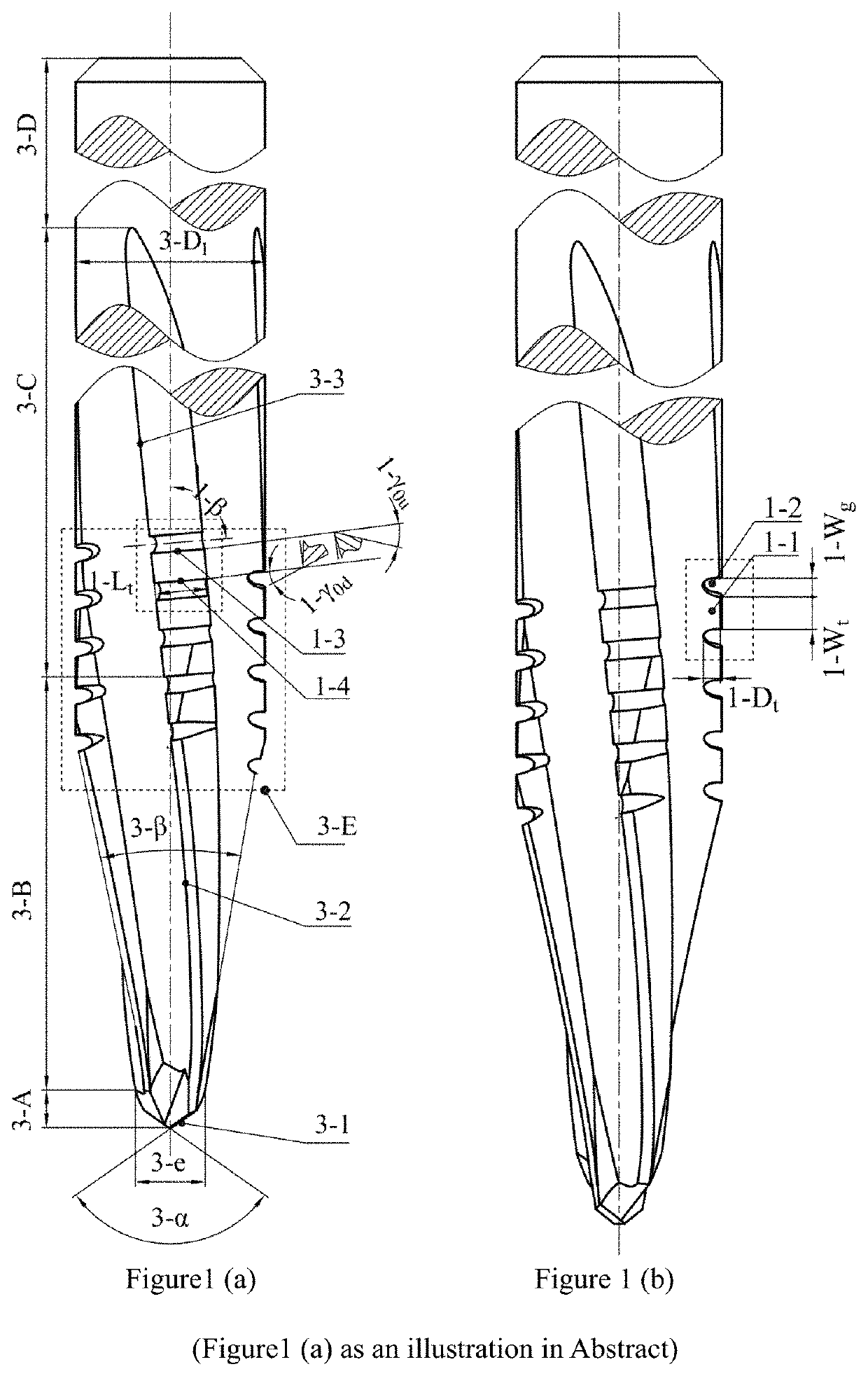Sawtooth structure with reversed cutting function and its drill series
a sawtooth structure and function technology, applied in the field of drills, can solve the problems of weak bonding between two adjacent laminates, rapid tool wear, and dull cutting edges
- Summary
- Abstract
- Description
- Claims
- Application Information
AI Technical Summary
Benefits of technology
Problems solved by technology
Method used
Image
Examples
embodiment 1
[0035]FIG. 2 shows an intersecting-sawtooth double point angle drill of claim 2. The drill can be divided into five zones: the primary cutting zone 2-A formed by the envelope curves of primary cutting edges 2-1, the secondary cutting zone 2-B formed by the envelope curves of secondary cutting edges 2-2, the left-hand minor cutting zone 2-C whose envelope curves are final hole, the clamping zone 2-D and the sawtooth cutting zone 2-E. Among them, the primary cutting zone 2-A has two primary cutting edges 2-1, and the first point angle 2-α is obtuse, which leads to the high rigidity of the primary cutting edge and preferable centering effect to ensure the drilling smoothly. The implementation adopts 2-α=118°; the secondary cutting zone 2-B has four secondary cutting edges 2-2, and the second point angle 2-β is acute, which results in the sharp secondary cutting edge 2-2, low thrust force and delamination. The minor cutting edge 2-3 adopts low left-hand helix angle to decrease thrust fo...
embodiment 2
[0037]FIGS. 1(a) and (b) shows a right-hand-sawtooth double point angle drill of claim 3. The drill can be divided into four zones: the primary cutting zone 3-A, the secondary cutting zone 3-B, the minor cutting zone 3-C, and clamping zone 3-D. In addition, the sawtooth cutting zone 3-E locates in the joint of the secondary cutting zone 3-B and the minor cutting zone 3-C which consists of several sawteeth 1-1 and grooves 1-2. The sawtooth cutting zone 3-E is formed by the sawtooth structure distributed in each cutting edge. There are one sawtooth 1-1 in the secondary cutting edge and four sawteeth 1-1 in the minor cutting edge. The sawteeth 1-1 in all cutting edges is right-hand. The top edges 1-3 act as cutting edges and are ground into positive rake angle 1-γ0u that equals to 20°.
[0038]Drilling can be divided into five stages: The first stage is crushing. The chisel edge contacts and crushs the workpiece. Because of the crushing effect of it, thrust force increases rapidly; the se...
embodiment 3
[0041]FIGS. 4, 5 and 6 show a right-hand-sawtooth twist drill of claim 4. It can be divided into four zones: the primary cutting zone 4-A formed by the outline of the primary cutting edge 4-1, the minor cutting zone 4-B formed by the outline of the primary cutting edge 4-1 terminal and minor cutting edge 4-2, the clamping zone 4-C and the sawtooth cutting zone 4-D. Two primary cutting edges 4-1 develop low point angle 4-α, which is beneficial to decrease thrust force and delamination; the minor cutting edge 4-2 is designed with sawtooth structure, which realizes the rebounding into the sawtooth structure and cutting off for generating burrs in drilling. It can eliminate the burrs effectively at the exit and entrance, and decrease the cracks in the final hole; the minor cutting edge 4-2 adopts right-hand structure, and it contributes to removing burrs; each of the primary cutting edges 4-1 have two flank surfaces. It will decrease the friction between drill and workpiece, cutting hea...
PUM
 Login to View More
Login to View More Abstract
Description
Claims
Application Information
 Login to View More
Login to View More - Generate Ideas
- Intellectual Property
- Life Sciences
- Materials
- Tech Scout
- Unparalleled Data Quality
- Higher Quality Content
- 60% Fewer Hallucinations
Browse by: Latest US Patents, China's latest patents, Technical Efficacy Thesaurus, Application Domain, Technology Topic, Popular Technical Reports.
© 2025 PatSnap. All rights reserved.Legal|Privacy policy|Modern Slavery Act Transparency Statement|Sitemap|About US| Contact US: help@patsnap.com



